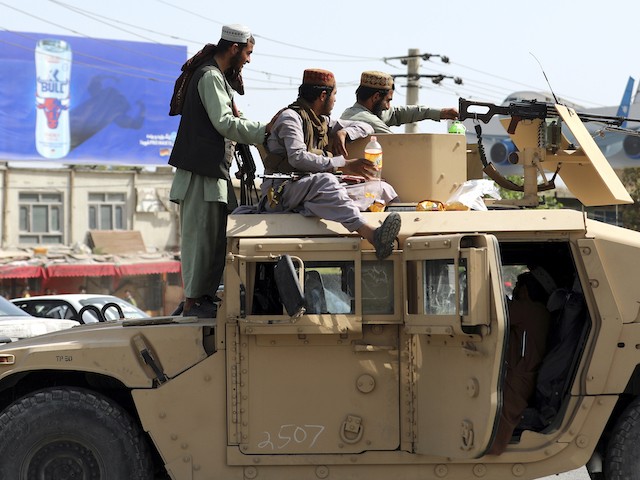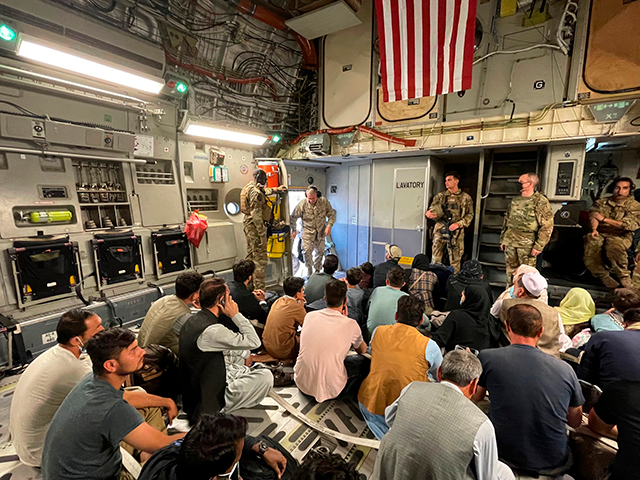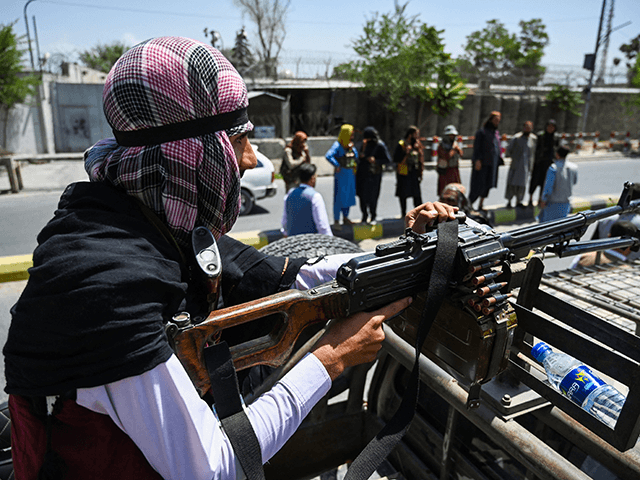Gen. Frank McKenzie, commander of U.S. Central Command (CENTCOM), released a statement Tuesday that said Hamid Karzai International Airport in Kabul has been secured and is once again open to civilian air traffic.
McKenzie warned the Taliban not to interfere with U.S. evacuation efforts and threatened to respond to any attack with “overwhelming force.” Reports nevertheless flooded in of Taliban fighters blocking access to the airport and brutalizing men, women, and children who tried to get past their checkpoints.

Taliban fighters stand guard in front of the Hamid Karzai International Airport, in Kabul, Afghanistan, Monday, Aug. 16, 2021. Thousands of people packed into the Afghan capital’s airport on Monday, rushing the tarmac and pushing onto planes in desperate attempts to flee the country after the Taliban overthrew the Western-backed government. (AP Photo/Rahmat Gul)
McKenzie said he personally evaluated the situation at the airport and is satisfied with “the work our forces are doing to efficiently operate the airfield while ensuring the safe movement of civilians and diplomats who are leaving Kabul.”
The CENTCOM chief said it was safe to resume civilian operations at the airport, with due caution, and warned Taliban leaders not to interfere:
U.S. military air traffic controllers and ground handlers are rapidly scaling up operations to ensure the smooth flow of military reinforcements to the airport and the evacuation of U.S. and partner civilians in coordination with our State Department colleagues.
Currently, the airfield is secure and now open to civilian air traffic operating under visual flight rules.
In meetings with Taliban senior leaders in Doha on Sunday, I cautioned them against interference in our evacuation, and made it clear to them that any attack would be met with overwhelming force in the defense of our forces.
“I remain enormously proud of the men and women of our armed forces, who are accomplishing this mission with skill, compassion and professionalism,” McKenzie concluded.

U.S. Marine Corps Gen. Frank McKenzie, the commander of U.S. Central Command, enters a plane evacuating people, at Hamid Karzai International Airport, Afghanistan, Tuesday, Aug. 17, 2021. (Capt. William Urban/U.S. Navy via AP)
Ross Wilson, charge d’affaires at the U.S. embassy in Kabul, on Tuesday refuted reports that he fled the country and said he was still working to help Americans and fleeing Afghans reach the airport.
“Embassy staff and I remain in Kabul working hard to help thousands of U.S. citizens and vulnerable Afghans and continuing engagement here. Our commitment to the Afghan people endures,” Wilson said on Twitter.
CNBC reported the airport reopened on Tuesday morning after “U.S. forces closed it for several hours due to the chaotic security situation,” with security and air traffic control “taken over by the U.S. military.”
There did appear to be some limited commercial activity at the airport on Tuesday:
Commercial flights remain extremely limited, with some canceled. But a handful of flights are still scheduled to go to Istanbul and a few cities within Afghanistan, according to flight monitoring website FlightRadar24. Flydubai has suspended flights from Dubai to Kabul through at least Wednesday, while Emirates Airline said its Kabul flights are suspended “until further notice.”
The only commercial airlines scheduled to depart are local carriers Kam Air and Ariana Afghan Airlines, according to FlightRadar24.
Some in Afghanistan have described extremely high ticket prices and being turned away by airlines due to flights being overbooked.
Germany’s Lufthansa airline announced three flights to bring evacuees from Afghanistan to Frankfurt, but they are scheduled to pick up passengers from neighboring countries, not direct from Kabul. The first of these flights, departing from Uzbekistan’s capital of Tashkent with passengers already evacuated from Kabul by the German air force, arrived in Frankfurt on Wednesday morning.
Aviation websites confirmed on Wednesday that at least one commercial aircraft, a Utair Boeing 767 from Vnukovo International Airport in Russia, has landed in Kabul.
As Gen. McKenzie indicated in his statement, CENTCOM is instructing commercial pilots that they cannot perform instrument landings in Kabul and must rely on visual flight rules. Inbound planes must request permission before landing. CENTCOM will grant them 30-minute windows to complete the landing process. The military is also warning pilots the civilian side of the Kabul airport is suffering an aviation fuel shortage, so they must land with enough fuel to depart again.
Getting to Hamid Karzai International Airport from other parts of Kabul or Afghanistan remains dangerous and uncertain.
The Taliban promised to allow safe passage for refugees, but the Biden White House said on Tuesday there are reports of civilians “being turned away, or pushed back, or even beaten” by Taliban thugs.
The Pentagon said on Tuesday it is communicating “multiple times per day” with Taliban commanders to avoid “hostile interactions from the Taliban” at the airport.
The Taliban might be largely behaving itself in the immediate vicinity of the airport, but elsewhere in Afghanistan, there are reports of Taliban fighters rejecting and even attacking evacuees at checkpoints.
Marcus Yam, an L.A. Times reporter in Afghanistan, on Tuesday photographed a woman and child beaten bloody by the Taliban at a traffic circle in Kabul just outside the airport. The reporter himself was “whipped in the leg” when he tried to photograph Taliban fighters beating back the crowds, pointing guns at them, and firing shots in the air.
CNN correspondent Clarissa Ward also said armed Taliban fighters threatened her and claimed they intended to “pistol-whip” her producer. “We had to intervene and scream,” she said, describing the situation outside the airport as “mayhem,” “dangerous,” and “nuts.”
Fox News quoted an Afghan who formerly worked for the U.S. State Department saying Taliban fighters turned him away from the airport. “You can go, don’t run away,” they said after confronting him.
“There was kids women, babies, old women, they could barely walk. They were very very bad situation, I’m telling you. At the end, I was thinking that there was like 10,000 or more than 10,000 people and they’re running into the airport,” the contractor said.
“The Taliban [were] beating people, and the people were jumping from the fence, the concertina wire, and also the wall,” he said.
The Wall Street Journal (WSJ) on Wednesday confirmed that accessing the Kabul airport remains “extremely difficult, with Taliban checkpoints pushing Afghans back and no clear system to bring people in.”
“Beyond the Taliban checkpoints, U.S. Marines at the gates of the airport focused mostly on keeping anyone from coming close. As a result, many of the evacuation flights continued leaving with empty seats even as tens of thousands of Afghans who worked with Western governments clamored for a way out before the Taliban track them down,” the WSJ reported.
The Taliban on Wednesday responded to these reports by claiming “men impersonating the Taliban” are responsible for using violence to keep people away from the airport.

COMMENTS
Please let us know if you're having issues with commenting.